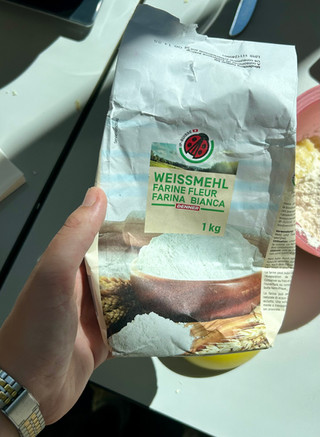Shaping Tradition and Culture in Dough
- camillemarraccini
- Sep 9
- 3 min read
Vegan Pasta Making!
Green Food Lab
Riva San Vitale, Switzerland
Written By: Camille Marraccini
September 9th, 2025

This week, the SALUTE students teamed up again with Chef Elisa Lazzari for our second Green Food Lab of the semester. In this lab, we focused on learning how to make different types of pasta, all vegan and using local ingredients. Elisa set up our kitchen classroom beautifully, and we began by talking about the different types of flours and how they influence the taste and texture of pasta.
Since we were making vegan pasta, we had to move away from traditional methods and find substitutes for eggs in the dough. We started with gnocchi, which was made from 80 g flour, 225 g cooked potatoes, and a pinch of salt. The potatoes were boiled whole until soft and tender. This step is important, since peeling the potatoes before boiling allows key starches and nutrients, which are essential for gnocchi texture, to escape into the water. Once boiled, we peeled the skins, put the potatoes through a ricer, and mixed them with flour. After kneading the dough until smooth, we rolled it into long “snakes” and cut them into bite sized cubes.

The most fun part was shaping the gnocchi. I used the back of a fork, just like my grandmother taught me, while others experimented with different methods. What struck me most was how gnocchi shapes vary around the world. In northern Italy and parts of Switzerland, gnocchi are often rolled with ridges using a wooden board, while in other regions they may be pressed simply with a fork, or even left as rustic little pillows of dough. No two gnocchi ever look the same! Each shape reflects the culture, traditions, and even the personality of the cook. For me, pasta is more than food because it tells a story on the plate. After shaping our gnocchi, Elisa boiled them until they floated to the top (a clear sign they were perfectly cooked) and then served them with a simple tomato and basil sauce. The result was fresh, comforting, and absolutely delicious.
Next, we made a vegan pasta dough using naturally dyed waters from ingredients found in the wild. Purple came from beets, yellow from turmeric, and green/blue from spirulina (a dried biomass of cyanobacteria). The colorful doughs made it fun to experiment with shapes and designs.

Next, we made a vegan pasta dough using naturally dyed waters from ingredients found in the wild. Purple came from beets, yellow from turmeric, and green/blue from spirulina (a dried biomass of cyanobacteria). The colorful doughs made it fun to experiment with shapes and designs.
To make the pasta dough, we combined 100 g of flour, 80 g of semolina, 100 g of water, 8 g of oil, and a pinch of salt. Everyone says that semolina flour is “amazing for pasta making”, but no one ever asks why. It turns out that semolina is a coarse durum wheat flour, rich in protein and gluten, which ultimately gives the pasta its structure and bite. The most surprising ingredient was vinegar, which helped prevent oxidation and kept the vegan dough from turning an unappetizing gray-green color. Oxidation is a natural chemical reaction that happens when dough is exposed to air, similar to how an apple browns after you slice it. Normally, eggs in traditional pasta act as a buffer, slowing the oxidation process. Without eggs, the dough is more vulnerable, but adding a splash of vinegar changes the pH and slows the browning process (just like squeezing lemon juice on guacamole keeps it green and fresh) This small adjustment kept our pasta looking bright and appetizing while we worked.

After kneading the dough, we let it rest for an hour, then rolled it out on floured tables using both rolling pins and pasta rollers. From our sheets, we shaped farfalle, spaghetti, and fettuccine. Elisa also prepared a vegan pasta filling made from spinach and mushrooms, which we used to create delicate little tortellini. She cooked them fresh and served them with just a drizzle of olive oil, allowing the flavor of the pasta and filling to shine.

From this lab, I learned that pasta making is both a science and an art. I discovered how potatoes provide essential starch for gnocchi, how vinegar prevents oxidation in vegan dough, and how semolina flour gives pasta the right structure. I also saw how natural dyes like beets, turmeric, and spirulina can transform pasta into colorful works of art! Most importantly, I realized that pasta carries culture and tradition in its shapes and methods, whether through my grandmother’s “fork rolled gnocchi” or Elisa’s creative vegan tortellini filling, each piece tells a story about place, people, and flavor. It makes me wonder what other foods I cook carry my own cultural twist, and how I might pass those traditions on to others?

































Comments